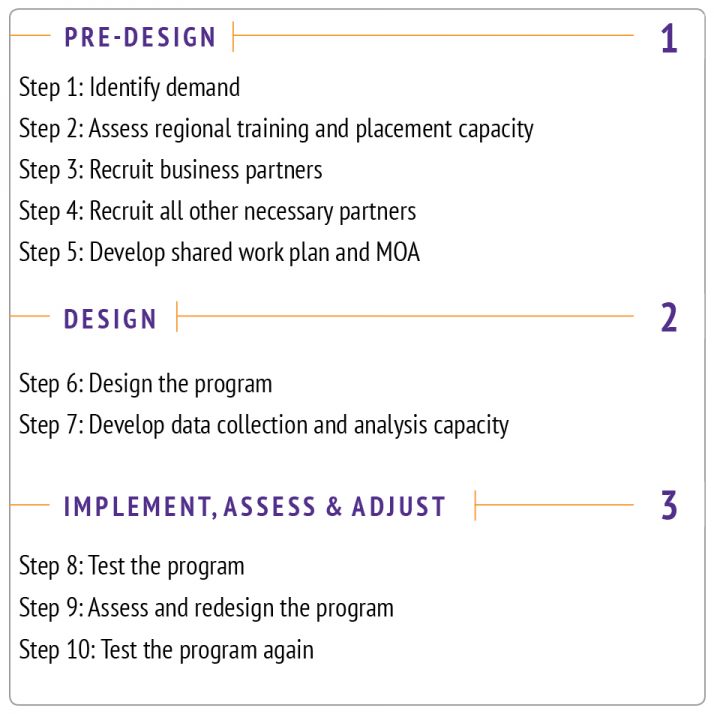Como Nancy presentó, esta es la cuarta y última publicación de nuestra serie de blogs Spring WCTF, Lograr resultados impactantes: observaciones de WCTF. En la publicación de hoy, la vicepresidenta sénior de CommCorp, Rebekah Lashman, explorará las características de las asociaciones sectoriales exitosas.
En los últimos 10 años hemos invertido
Fondo Fiduciario para la Competitividad de la Fuerza Laboral (Workforce Competitiveness Trust Fund, WCTF) y otros recursos estatales y federales en más de 80 programas que han sido diseñados y administrados por asociaciones del sector industrial regional. Nuestro objetivo para estas inversiones ha sido preparar y ubicar a los residentes de Massachusetts que de otro modo no serían considerados buenos candidatos en puestos de trabajo que están en demanda por parte de las empresas regionales. Algunos de los programas han tenido mucho éxito; otros han luchado. Como los hemos observado a lo largo de los años, hemos desarrollado algunas conclusiones sobre las características de las asociaciones sectoriales exitosas. Se dividen en tres cubos:
Claridad de enfoque
Partnerships that focus on specific labor market problems develop more effective programs. They are more likely to invest in continuous improvement and are in a better position to meet additional needs of the targeted industry.
We suggest that partnership members pick a single occupation (or a closely-related set of occupations) for which there is clear evidence that there is current and near-term (one to two years) demand for workers. Last month my colleague Theresa Rowland and I had the privilege of offering a workshop at the Commonwealth Workforce Coalition Conference. We shared some resources for identifying an occupation and included
una guía para entrevistar a empleadores regionales sobre la demanda ocupacional.
We also suggest that partnerships focus on a target population around which they will design the program. The most successful industry sector programs address the intersection between the skills and knowledge required for an occupation and the experience and skills that are attainable for a target population within a reasonable timeframe.
Haga clic aquí para otro recurso donde compartimos algunas reflexiones adicionales sobre cómo abordar este análisis.
Complementariedad: de las misiones, los recursos y la experiencia de los miembros
We’re all crazy busy and are feeling under increasing pressure to do more with less. No one, whether they work for a non-profit or public agency or a private organization, will remain committed to and engaged in a group for very long if the work isn’t aligned in some way with the mission of their organization and if they don’t have relevant resources or expertise to contribute to the group. There just isn’t enough time in the day or week. Every member of the partnership should be able to articulate what they or their organization will gain from participating and what they are bringing to the table that is essential for success. In our RFPs we always insist that a sector partnership include businesses that have a current and likely ongoing need for workers in the targeted occupation. The business members have the most information about the skill requirements for the occupation and about hiring practices and organizational culture. They should certainly participate in the program design and can often play a role in instruction, particularly if they can contribute a skilled worker who also has been trained in effective teaching methods.
But there are many other areas of expertise that are essential for an effective industry sector program and are not likely to be in a business member’s wheelhouse. These include recruitment, assessment, social services, case management and career coaching, work readiness skill building, contextualized literacy, numeracy, English-language proficiency, and job development.
We’re currently working with eight partnerships whose members are engaged in a rigorous program design exercise in which they are assessing and revising every element of their programs to ensure that they meet the requirements of their target occupations and the needs of their target populations. We’ve been learning along with them – our colleague Anthony Britt discussed the
elementos esenciales del diseño de programas en su blog en mayo. También hemos desarrollado un
bosquejo de las fases del desarrollo del programa del sector industrial y algunos pasos sugeridos.

Como puede ver, creemos que es casi imposible sobreestimar el nivel de esfuerzo e inversión necesarios para llevar a cabo un diseño y ejecución de programas efectivos. Sugerimos que a lo largo del proceso de diseño, los miembros de la asociación realicen un inventario extenso de la experiencia, la capacidad y los recursos necesarios para garantizar que la asociación tenga la capacidad colectiva para tener éxito en el diseño y la ejecución del programa.
Compromiso: funciones, responsabilidades y toma de decisiones basada en datos
A lo largo de los años, los miembros de la asociación nos han dicho que son más efectivos cuando tienen claro lo que se han comprometido a hacer, qué papel están desempeñando, cómo se tomarán las decisiones y cómo sabrán si su programa es exitoso. Es esencial identificar una organización que sirva como convocante y personal de la asociación. Hablamos de esto en nuestro
Guía de asociación in detail but the most critical capacities for the convener include relationship management, participant-level data collection and analysis and fiscal and project management.
We also believe strongly that members should develop a shared program development work plan and an MOA that articulates the role, responsibility and resource commitments of each member of the partnership as well as the decision making processes.
Finally, as
Theresa sugirió en su blog en abril, the work of industry sector partnerships must be data-driven. The members should insist on, and commit to participating in, a continuous process improvement cycle. In order to do this, they will need identify the data required to assess the effectiveness of each program element, develop data collection and analysis capacity, and establish a schedule and protocol for reviewing the data and revising the program as needed.
None of this is easy. After all, industry sector partnerships are coming together to solve labor market
problemas. Pero creemos que es esencial si queremos tener éxito en asegurar que los residentes de Massachusetts estén preparados para satisfacer las necesidades de talento de las empresas de nuestro estado. ¿Qué le ha enseñado su experiencia sobre las asociaciones del sector industrial? Contribuya a nuestros esfuerzos continuos para compartir lecciones y prácticas efectivas.
Escrito por Rebekah Lashman, vicepresidenta sénior de estrategias sectoriales de Commonwealth Corporation. Rebekah lidera el diseño de las inversiones de CommCorp en programas sectoriales de mejora de habilidades y empleo, incluido el Fondo Fiduciario para la Competitividad de la Fuerza Laboral y el Fondo de Capacitación de la Fuerza Laboral.
 Como puede ver, creemos que es casi imposible sobreestimar el nivel de esfuerzo e inversión necesarios para llevar a cabo un diseño y ejecución de programas efectivos. Sugerimos que a lo largo del proceso de diseño, los miembros de la asociación realicen un inventario extenso de la experiencia, la capacidad y los recursos necesarios para garantizar que la asociación tenga la capacidad colectiva para tener éxito en el diseño y la ejecución del programa.
Como puede ver, creemos que es casi imposible sobreestimar el nivel de esfuerzo e inversión necesarios para llevar a cabo un diseño y ejecución de programas efectivos. Sugerimos que a lo largo del proceso de diseño, los miembros de la asociación realicen un inventario extenso de la experiencia, la capacidad y los recursos necesarios para garantizar que la asociación tenga la capacidad colectiva para tener éxito en el diseño y la ejecución del programa.

